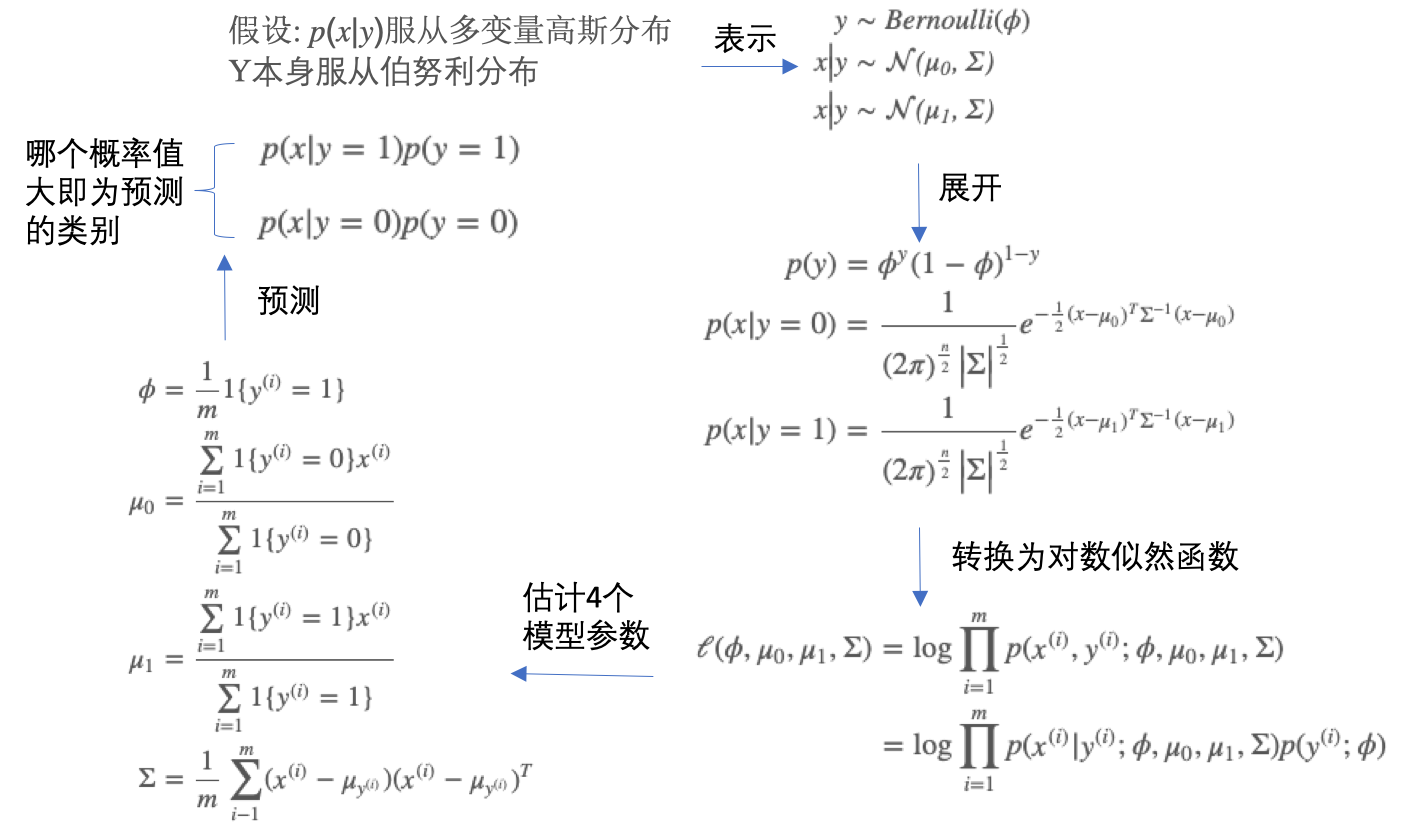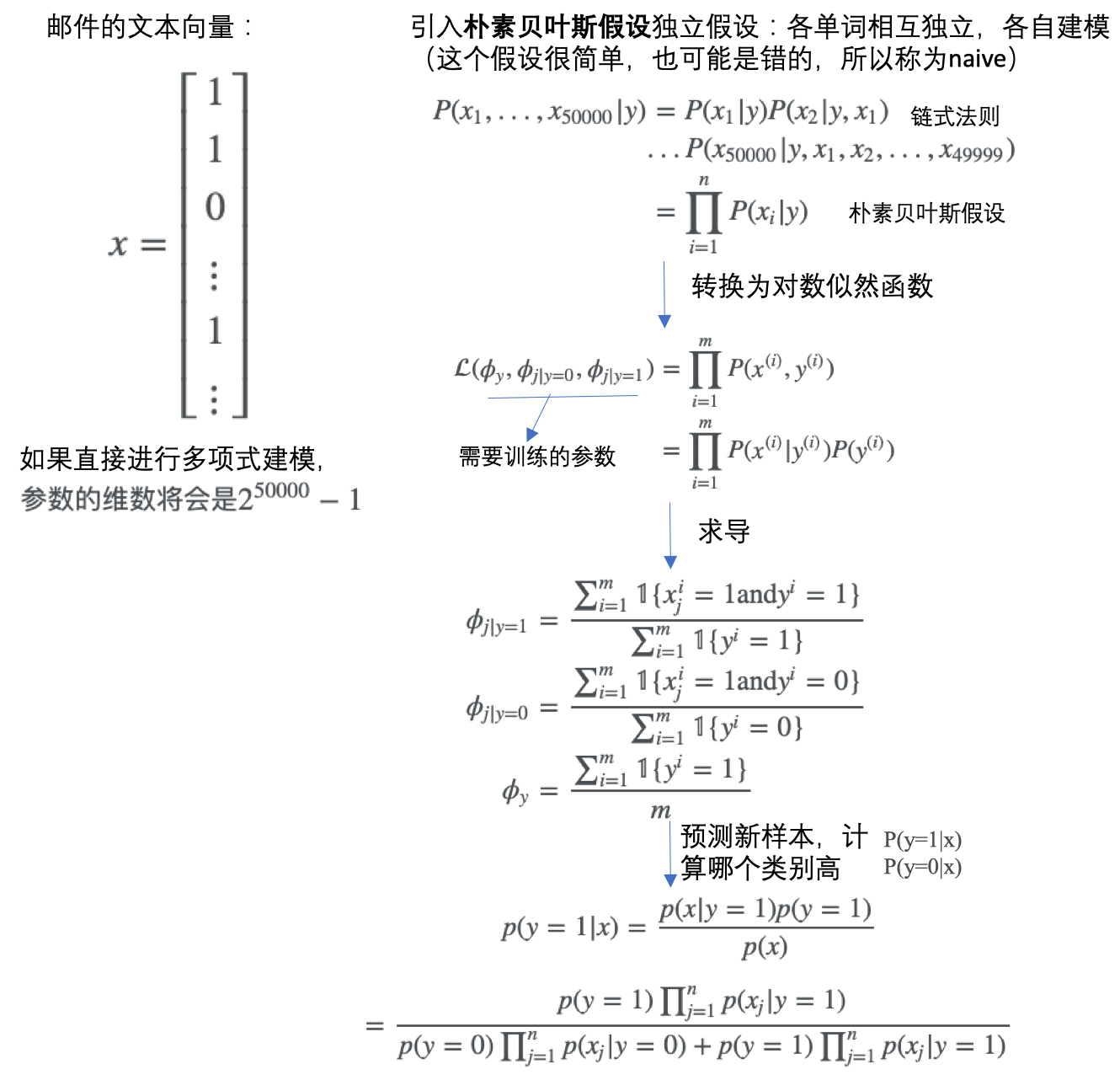生成式模型 vs 判别式模型
对于监督学习,其最终目标都是在给定样本时,预测其最可能的类别,即优化目标总是:\(\begin{align}\arg \max_yp(y\|x)\end{align}\)。
求解上述优化目标总的可分为两类:
- 判别式模型(Discriminant Model):直接学习模型得到\(p(y\|x)\),即根据数据集学习参数模型:\(p(y\|x; \theta)\),那么在预测的时候直接根据新样本的x特征值计算y值(所属的类别的概率)。此类包含:1)线性回归模型,2)逻辑回归模型,3)决策树模型 等
-
wiki: a generative model is a model of the conditional probability of the observable X, given a target y, symbolically,{P(X|Y=y)}.
- 生成式模型(Generative Model):利用贝叶斯法则,对上述的优化目标进行转换。
- wiki: a discriminative model is a model of the conditional probability of the target Y, given an observation x, symbolically,{P(Y|X=x)}
- 贝叶斯公式: \(p(y\|x)=\frac {p(x,y)}{p(x)}=\frac {p(x\|y)p(y)}{p(x)}\)
- 代入上面的优化目标:\(\begin{align}\arg \max_yp(y\|x)&=\arg \max_y\frac {p(x\|y)p(y)}{p(x)}\\&=\arg \max_yp(x\|y)p(y)\end{align} (给定数据x时,p(x)是常量可不考虑)\)
- 此时模型的求解目标不是\(p(y\|x)\),而是\(p(x\|y)\)和\(p(y)\)
| 判别模型 | 生成模型 | |
|---|---|---|
| 关注点 | 关注各类的边界 | 关注每一类的分布,不关注决策边界的位置 |
| 优点 | 1.能得到类之间的差异信息 2.学习简单 |
1.研究类内部问题更加灵活 2.更适合增量学习 3.对数据不完整适应更好,更鲁棒 |
| 缺点 | 1.不能得到每一类的特征(可以告诉你的是1还是2,但是没有办法把整个场景描述出来) 2.变量关系不清晰、不可视 |
1.学习计算相对复杂 2.更倾向于得到false positive,尤其是对比较近的事物分类(比如牛和马) |
| 举例 | LR、SVM、KNN、traditional neural network、conditional random field | naive bayes、mixtures of mutinomial/gaussians/experts、HMMs、Sigmoidal belief networks、bayesian networks、markov random fields |
例子
目标:判别一个动物是大象(y=1)还是狗(y=0)
判别式模型:
- 【训练】考虑动物的所有特征,学习模式\(p(y\|x; \theta)\)
- 【预测】基于学习的模型,判定是大象还是狗
生成式模型:
- 【训练1】训练所有的类别为大象的数据,学习模型1:\(p(x\|y=1)和p(y=1)\)
- 【训练2】训练所有的类别为狗的数据,学习模型2:\(p(x\|y=0)和p(y=0)\)
- 【预测】用模型1和2分别预测,可能性大的即为最终的预测类别
高斯判别分析
高斯判别分析(Gaussian discriminant analysismodel, GDA):
朴素贝叶斯
- 用于学习离散值随机变量
- 贝叶斯决策:选择具有最高概率的决策。对应于分类,即如果属于某一类别的概率是最大的,则分为该类别。
- 朴素:分类器过程中只做最原始、最简单的假设
- 条件概率:\({\displaystyle P(A\mid B)={\frac {P(B\mid A)P(A)}{P(B)}}}\)
- P(A|B)是已知B发生后A的条件概率,即A的后验概率。
- P(A)是A的先验概率
- P(B|A)是已知A发生后B的条件概率,即B的后验概率。
- P(B)是B的先验概率。
文本/邮件分类
对于上面的文本分类问题,涉及到具体的几个步骤:
1、数据准备:从文本构建词向量
- 通过
loadDataSet函数构建post文本内容及对应的标签(是否是侮辱性的) - 然后
createVocabList函数基于所有的文档,提取所有唯一的单词集合 setOfWords2Vec函数基于单词集合,把输入的post文本转换为一个单词向量,长度和单词集合相等,出现某单词则值为1,未出现则为0
def loadDataSet():
postingList=[['my', 'dog', 'has', 'flea', 'problems', 'help', 'please'],
['maybe', 'not', 'take', 'him', 'to', 'dog', 'park', 'stupid'],
['my', 'dalmation', 'is', 'so', 'cute', 'I', 'love', 'him'],
['stop', 'posting', 'stupid', 'worthless', 'garbage'],
['mr', 'licks', 'ate', 'my', 'steak', 'how', 'to', 'stop', 'him'],
['quit', 'buying', 'worthless', 'dog', 'food', 'stupid']]
classVec = [0,1,0,1,0,1] #1 is abusive, 0 not
return postingList,classVec
def createVocabList(dataSet):
vocabSet = set([]) #create empty set
for document in dataSet:
vocabSet = vocabSet | set(document) #union of the two sets
return list(vocabSet)
def setOfWords2Vec(vocabList, inputSet):
returnVec = [0]*len(vocabList)
for word in inputSet:
if word in vocabList:
returnVec[vocabList.index(word)] = 1
else: print "the word: %s is not in my Vocabulary!" % word
return returnVec
2、模型训练:基于词向量计算概率
trainMatrix:词向量矩阵,每一行是一个文本,每一列表示某个单词在该文本中是否出现trainCategory:文本所属的类别
根据这个函数,就可以计算出,在每个类别中每个单词出现的概率,具体这里是两个类别:侮辱性的(标记为1的)和非侮辱性的(标记为0的)。
def trainNB0(trainMatrix,trainCategory):
numTrainDocs = len(trainMatrix)
numWords = len(trainMatrix[0])
pAbusive = sum(trainCategory)/float(numTrainDocs)
p0Num = ones(numWords); p1Num = ones(numWords) #change to ones()
p0Denom = 2.0; p1Denom = 2.0 #change to 2.0
for i in range(numTrainDocs):
if trainCategory[i] == 1:
p1Num += trainMatrix[i]
p1Denom += sum(trainMatrix[i])
else:
p0Num += trainMatrix[i]
p0Denom += sum(trainMatrix[i])
p1Vect = log(p1Num/p1Denom) #change to log()
p0Vect = log(p0Num/p0Denom) #change to log()
return p0Vect,p1Vect,pAbusive
注意:
p0Num = ones(numWords); p1Num = ones(numWords)这里的初始化可以初始化为全0矩阵,但是如果某个单词没有出现,其概率为0,最后的乘积也为0,所以可以初始化为全1矩阵;p1Vect = log(p1Num/p1Denom)这里如果不取log,有可能由于太多的很小的数值相乘造成下溢出问题,所以去对数。
3、模型测试
根据训练数据,已经计算了每个类别中每个单词的出现频率。对于新的文本数据,就可以基于此来计算此文本属于每一个类别的概率,最后文本所属的类别就是概率值最大的那一类。因为这里引入了贝叶斯假设,认为不同的单词之间是相互独立的,所以可以直接计算得到概率,就是下面的vec2Classify * p1Vec和vec2Classify * p0Vec,vec2Classify就是待分类文本的词向量,p1Vec是类别1中单词的概率,两者元素相乘再加和就是文本属于类别1的概率。
def classifyNB(vec2Classify, p0Vec, p1Vec, pClass1):
p1 = sum(vec2Classify * p1Vec) + log(pClass1) #element-wise mult
p0 = sum(vec2Classify * p0Vec) + log(1.0 - pClass1)
if p1 > p0:
return 1
else:
return 0
def testingNB():
listOPosts,listClasses = loadDataSet()
myVocabList = createVocabList(listOPosts)
trainMat=[]
for postinDoc in listOPosts:
trainMat.append(setOfWords2Vec(myVocabList, postinDoc))
p0V,p1V,pAb = trainNB0(array(trainMat),array(listClasses))
testEntry = ['love', 'my', 'dalmation']
thisDoc = array(setOfWords2Vec(myVocabList, testEntry))
print testEntry,'classified as: ',classifyNB(thisDoc,p0V,p1V,pAb)
testEntry = ['stupid', 'garbage']
thisDoc = array(setOfWords2Vec(myVocabList, testEntry))
print testEntry,'classified as: ',classifyNB(thisDoc,p0V,p1V,pAb)
词集模型 vs 词袋模型
- 词集模型(set-of-words model):所有单词只唯一的计数,每个单词只出现一次
- 词袋模型(bag-of-words model):每个单词可出现多次,次数越多,则在文档中出现的概率越大
# 词集模型
def setOfWords2Vec(vocabList, inputSet):
returnVec = [0]*len(vocabList)
for word in inputSet:
if word in vocabList:
returnVec[vocabList.index(word)] = 1
else: print "the word: %s is not in my Vocabulary!" % word
return returnVec
# 词袋模型
def bagOfWords2VecMN(vocabList, inputSet):
returnVec = [0]*len(vocabList)
for word in inputSet:
if word in vocabList:
returnVec[vocabList.index(word)] += 1
return returnVec
sklearn版本
参考这里的文档:
# load data
from sklearn.datasets import fetch_20newsgroups
twenty_train = fetch_20newsgroups(subset='train',
categories=categories, shuffle=True, random_state=42)
# Tokenizing text
from sklearn.feature_extraction.text import CountVectorizer
count_vect = CountVectorizer()
X_train_counts = count_vect.fit_transform(twenty_train.data)
# occurrences to frequencies
tfidf_transformer = TfidfTransformer()
X_train_tfidf = tfidf_transformer.fit_transform(X_train_counts)
# train NB model
from sklearn.naive_bayes import MultinomialNB
clf = MultinomialNB().fit(X_train_tfidf, twenty_train.target)
# test model
docs_new = ['God is love', 'OpenGL on the GPU is fast']
X_new_counts = count_vect.transform(docs_new)
X_new_tfidf = tfidf_transformer.transform(X_new_counts)
predicted = clf.predict(X_new_tfidf)
for doc, category in zip(docs_new, predicted):
print('%r => %s' % (doc, twenty_train.target_names[category]))
联合成一个pipeline:
# training
from sklearn.pipeline import Pipeline
text_clf = Pipeline([
('vect', CountVectorizer()),
('tfidf', TfidfTransformer()),
('clf', MultinomialNB()),
])
text_clf.fit(twenty_train.data, twenty_train.target)
# testing
import numpy as np
twenty_test = fetch_20newsgroups(subset='test',
categories=categories, shuffle=True, random_state=42)
docs_test = twenty_test.data
predicted = text_clf.predict(docs_test)
np.mean(predicted == twenty_test.target)
参考
If you link this blog, please refer to this page, thanks!
Post link:https://tsinghua-gongjing.github.io/posts/discriminant-generative-bayes-gaussian.html
Latest articles
Links
- ZhangLab , RISE database , THU life , THU info
- Data analysis: pandas , numpy , scipy
- ML/DL: sklearn , sklearn(中文) , pytorch
- Visualization: seaborn , matplotlib , gallery
- Github: me

